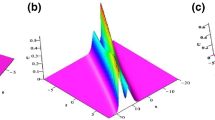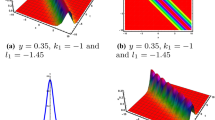Abstract
A new discrete complex coupled mKdV equation related to the fourth-order linear spectral problem is proposed. Firstly, we construct a new discrete integrable hierarchy for this equation by Tu-scheme method, from which its higher-order versions can be expressed. Secondly, using the continuous limit, we map this discrete complex coupled equation to a continuous coupled mKdV equation. Thirdly, we discuss the modulation instability to analyze the generation mechanism of different localized waves. Then, the discrete generalized \((z, N-z)\)-fold Darboux transformation in matrix form is constructed for the first time, from which three types of position regulatable rogue waves, periodic waves and their hybrid interaction patterns are discussed graphically. Finally, the large-parameter asymptotic is applied to analyze the asymptotic states of second-order rogue wave at infinity, and the numerical simulations of some rogue wave solutions are performed to analyze their dynamical behaviors. These results might be helpful for understanding the wave motion and soliton propagation in shallow water and ultrashort pulsed media.













Similar content being viewed by others
Data Availability
The datasets generated during and/or analyzed during the current study are available from the corresponding author on reasonable request.
References
Wazwaz, A.M., Kaur, L.: Complex simplified Hirota’s forms and Lie symmetry analysis for multiple real and complex soliton solutions of the modified KdV-Sine-Gordon equation. Nonlinear Dyn. 95, 2209–2215 (2019)
Wadati, M.: Transformation theories for nonlinear discrete systems. Prog. Theor. Phys. Suppl. 59, 36–63 (1976)
Ablowitz, M.J., Prinari, B., Trubatch, A.D.: Discrete and continuous nonlinear Schrödinger systems. Cambridge University Press, Cambridge (2004)
Wei, C.C., Tian, B., Yang, D.Y., Liu, S.H.: Jacobian-elliptic-function and rogue-periodic-wave solutions of a higher-order nonlinear Schrödinger equation in an inhomogeneous optical fiber. Chin. J. Phys. 81, 354–361 (2023)
Ablowitz, M.J.: Nonlinear evolution equations-continuous and discrete. SIAM Rev. 19, 663 (1977)
Leblond, H., Mihalache, D.: Optical solitons in the few-cycle regime: recent theoretical results. Rom. Rep. Phys. 63, 1254–1266 (2011)
Ankiewicz, A., Akhmediev, N.: Rogue wave-type solutions of the mKdV equation and their relation to known NLSE rogue wave solutions. Nonlinear Dyn. 91, 19311–1938 (2018)
Liu, P., Jia, M., Lou, S.Y.: Lax pair and exact solutions of a discrete coupled system related to coupled KdV and coupled mKdV equations. Phys. Scr. 76, 674–679 (2007)
Wen, X.Y., Hu, X.Y.: \(N\)-fold Darboux transformation and solitonic interactions for a Volterra lattice system. Adv. Differ. Equ. 213, 1–16 (2014)
Yu, Y.X., Wang, Q., Zhang, H.Q.: New explicit rational solitary wave solutions for discretized mKdV lattice equation. Commun. Theor. Phys. 44, 1011–1014 (2005)
Zha, Q.L.: Sirendaoreji: A hyperbolic function approach to constructing exact solitary wave solutions of the hybrid lattice and discrete mKdV lattice. Chin. Phys. 15, 475–477 (2006)
Sahadevan, R., Balakrishnan, S.: Complete integrability of two-coupled discrete modified Korteweg-de Vries equations. J. Phys. A 42, 415208 (2009)
Zhang, W.X., Liu, Y.: Solitary wave solutions and integrability for generalized nonlocal complex modified Korteweg-de Vries (cmKdV) equations. AIMS Math. 6, 11046–11075 (2021)
Liu, L., Wen, X.Y., Liu, N., Jiang, T., Yuan, J.Y.: An integrable lattice hierarchy associated with a \(4 \times 4\) matrix spectral problem: \(N\)-fold Darboux transformation and dynamical properties. Appl. Math. Comput. 387, 124525 (2020)
Wazwaz, A.M.: Painlevé integrability and lump solutions for two extended \((3+1)\)- and \((2+1)\)-dimensional Kadomtsev-Petviashvili equations. Nonlinear Dyn. 111, 3623–3632 (2023)
Wazwaz, A.M.: New \((3+1)\)-dimensional Painlevé integrable fifth-order equation with third-order temporal dispersion. Nonlinear Dyn. 106, 891–897 (2021)
Tu, G.: A trace identity and its applications to the theory of discrete integrable systems. J. Phys. A 23, 3903 (1990)
Yuan, C.L., Wen, X.Y.: Integrability, discrete kink multi-soliton solutions on an inclined plane background and dynamics in the modified exponential Toda lattice equation. Nonlinear Dyn. 105, 643–669 (2021)
Zhang, R.F., Li, M.C., Cherraf, A., Vadyala, S.R.: The interference wave and the bright and dark soliton for two integro-differential equation by using BNNM. Nonlinear Dyn. 111, 8637–8646 (2023)
Zhang, R.F., Li, M.C., Gan, J.Y., Li, Q., Lan, Z.Z.: Novel trial functions and rogue waves of generalized breaking soliton equation via bilinear neural network method. Chaos Soliton. Fract. 154, 111692 (2022)
Wang, H.T., Li, X., Zhou, Q., Liu, W.J.: Dynamics and spectral analysis of optical rogue waves for a coupled nonlinear Schrödinger equation applicable to pulse propagation in isotropic media. Chaos Soliton. Fract. 166, 112924 (2023)
Yuan, C.L., Yang, H.J., Meng, X.K., Tian, Y., Zhou, Q., Liu, W.J.: Modulational instability and discrete rogue waves with adjustable positions for a two-component higher-order Ablowitz-Ladik system associated with \(4\times 4\) Lax pair. Chaos Soliton. Fract. 168, 113180 (2023)
Zhang, R.F., Li, M.C., Albishari, M., Zheng, F.C., Lan, Z.Z.: Generalized lump solutions, classical lump solutions and rogue waves of the \((2+1)\)-dimensional Caudrey-Dodd-Gibbon-Kotera-Sawada-like equation. Appl. Math. Comput. 403, 126201 (2021)
Wazwaz, A.M.: A completely integrable system of coupled modified KdV equation. J. Nonlinear Opt. Phys. Mater. 19, 145–151 (2010)
Wazwaz, A.M., Xu, G.Q.: An extended modified KdV equation and its Painlevé integrability. Nonlinear Dyn. 86, 1455–1460 (2016)
Liu, Y., Wang, D.S.: Exotic wave patterns in Riemann problem of the high-order Jaulent-Miodek equation: Whitham modulation theory. Stud. Appl. Math. 149, 588–630 (2022)
Liu, T.S., Xia, T.C.: Multi-component generalized Gerdjikov-Ivanov integrable hierarchy and its Riemann-Hilbert problem. Nonlinear Anal. Real World Appl. 68, 103667 (2022)
Ma, W.X.: Application of the Riemann–Hilbert approach to the multicomponent AKNS integrable hierarchies. Nonlinear Anal. Real World Appl. 47, 1–17 (2019)
Wen, X.Y., Yan, Z., Malomed, B.A.: Higher-order vector discrete rogue-wave states in the coupled Ablowitz-Ladik equations: exact solutions and stability. Chaos 26, 123110 (2016)
Wen, X.Y., Yang, Y., Yan, Z.: Generalized perturbation \((n, M)\)-fold Darboux transformations and multi-rogue-wave structures for the modified self-steepening nonlinear Schrödinger equation. Phys. Rev. E 92, 012917 (2015)
Matveev, V.B., Salle, M.A.: Darboux transformation and soliton. Springer, Berlin (1991)
Lin, Z., Wen, X.Y.: Continuous limit and location-manageable discrete loop rogue wave solutions for the semi-discrete complex short pulse equation. Results Phys. 39, 105680 (2022)
Wen, X.Y., Wang, H.T.: Breathing-soliton and singular rogue wave solutions for a discrete nonlocal coupled Ablowitz-Ladik equation of reverse-space type. Appl. Math. Lett. 111, 106683 (2021)
Wang, H.T., Wen, X.Y.: Modulational instability, interactions of two-component localized waves and dynamics in a semi-discrete nonlinear integrable system on a reduced two-chain lattice. Eur. Phys. J. Plus 136, 461 (2021)
Wen, X.Y., Meng, X.H., Xu, X.G., Wang, J.T.: \(N\)-fold Darboux transformation and explicit solutions in terms of the determinant for the three-field Blaszak-Marciniak lattice. Appl. Math. Lett. 26, 1076–1081 (2013)
Zhang, T., Wen, X.Y., Liu, X.K.: Continuous limit, higher-order rational solutions and relevant dynamical analysis for Belov-Chaltikian lattice equation with \(3\times 3\) Lax pair. Pramana-J. Phys. 97, 31 (2023)
Liu, X.K., Wen, X.Y.: Continuous limit, rational solutions, and asymptotic state analysis for the generalized Toda lattice equation associated with \(3\times 3\) Lax pair. Symmetry 14, 920 (2022)
Liu, X.K., Wen, X.Y., Lin, Z.: Continuous limit and position adjustable rogue wave solutions for the semi-discrete complex coupled system associated with \(4\times 4\) Lax pair. Appl. Math. Lett. 133, 108279 (2022) )
Wen, X.Y., Yuan, C.L.: Controllable rogue wave and mixed interaction solutions for the coupled Ablowitz-Ladik equations with branched dispersion. Appl. Math. Lett. 123, 107591 (2022
Bronsard, S.A., Pelinovsky, D.E.: New integrable semi-discretizations of the coupled nonlinear Schrödinger equations. arXiv:1705.05974
Wang, H.T., Wen, X.Y.: Dynamics of multi-soliton and breather solutions for a new semi-discrete coupled system related to coupled NLS and coupled complex mKdV equations. Mod. Phys. Lett. B 32, 185034 (2018)
Zhang, G.Q., Ling, L., Yan, Z.: Multi-component Nonlinear Schrödinger equations with nonzero boundary conditions: higher-order vector peregrine solitons and asymptotic estimates. J. Nonlinear Sci. 31, 81 (2021)
Yang, B., Yang, J.K.: Universal rogue wave patterns associated with the Yablonskii-Vorob’ev polynomial hierarchy. Physica D 425, 132958 (2021)
Trefethen, L.N.: Spectral methods in MATLAB. SIAM, Philadelphia (2000)
Wen, X.Y., Yan, Z., Zhang, G.: Nonlinear self-dual network equations: modulation instability, interactions of higher-order discrete vector rational solitons and dynamical behaviours. Proc. R. Soc. A 476, 20200512 (2020)
Acknowledgements
This work has been supported by National Natural Science Foundation of China Under Grant No. 12071042 and Beijing Natural Science Foundation Under Grant No. 1202006.
Author information
Authors and Affiliations
Corresponding author
Ethics declarations
Conflict of interest
The authors declare that there is no conflict of interests regarding the publication of this paper.
Additional information
Publisher's Note
Springer Nature remains neutral with regard to jurisdictional claims in published maps and institutional affiliations.
Appendix
Appendix
Rights and permissions
Springer Nature or its licensor (e.g. a society or other partner) holds exclusive rights to this article under a publishing agreement with the author(s) or other rightsholder(s); author self-archiving of the accepted manuscript version of this article is solely governed by the terms of such publishing agreement and applicable law.
About this article
Cite this article
Liu, XK., Wen, XY. & Lin, Z. Higher-order regulatable rogue wave and hybrid interaction patterns for a new discrete complex coupled mKdV equation associated with the fourth-order linear spectral problem. Nonlinear Dyn 111, 15309–15333 (2023). https://doi.org/10.1007/s11071-023-08627-z
Received:
Accepted:
Published:
Issue Date:
DOI: https://doi.org/10.1007/s11071-023-08627-z




